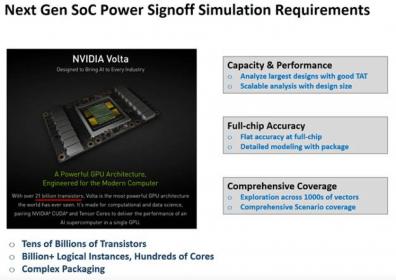Want to know how NVIDIA signs off on power integrity and reliability on mega-chips? Read on.
PPA over-design has repercussions in increased product cost and potential missed schedules with no guarantee of product success. Advanced SoCs pack more functionality and performance resulting in higher power density, but traditional approaches of uniformly over-designing the power grid which have worked in the past are no longer an option with severely constrained routing resources. To add to these problems, there are hundreds of combinations of PVT corners to consider for each of an increasing number of verification objectives.

REGISTER HERE for the webinar on Tuesday Nov 14[SUP]th[/SUP] at 8am PST
For example, an ADAS SoC is used for a variety of applications such as pedestrian detection, parking assist, vehicle exit assist, night vision, blind spot monitoring, collision avoidance, and a whole lot more. The numbers of vectors designers need to run simulations for have increased enormously. It is nearly impossible to uncover potential design weaknesses when you are simulating only a handful of vectors for just a fraction of second. How do you ensure you have enough design coverage?
Power grid design has become a limiting factor for achieving the desired performance and area targets in next generation SoCs. Sharper slew rates, higher current densities and faster switching speeds pose significant challenges to power integrity and reliability signoff. Lower operating voltages lead to tighter noise margins, resulting in a chip that is very sensitive to changes in supply voltage. Higher device density and longer wires in these advanced designs lead to increased node count by at least an order of magnitude posing significant capacity and performance challenges for traditional EDA tools to address.
As design size increases, turnaround time for solving billion-plus instance designs becomes critical. Next generation SoC power integrity and reliability signoff solution should scale elastically with capacity and performance. It is imperative to iterate designs over multiple operating conditions and scenarios rapidly, with an overnight turnaround time to maximize design coverage. Also, it is equally important to gain key insights from these large design databases to prioritize design fixes.
In this webinar, learn how NVIDIA has developed a workflow to run a flat, full-chip power integrity and reliability signoff analysis using a fully distributed compute and big data solution with ANSYS RedHawk-SC. They achieved a turn-around time of well under 24 hours for full-chip flat power signoff analysis on NVIDIA’s largest GPU – Volta, which contains around 21 billion transistors.
Additionally, silicon correlation exercises performed on the Volta chip using RedHawk-SC produced simulated voltage values that were within 10 percent of silicon measurement results. Discover how NVIDIA’s most powerful GPU uses ANSYS’ next generation SoC power signoff solution based on big data to deliver the best performance for cutting-edge AI and machine learning applications.
REGISTER HERE for the webinar on Tuesday Nov 14[SUP]th[/SUP] at 8am PST
About Ansys
If you’ve ever seen a rocket launch, flown on an airplane, driven a car, used a computer, touched a mobile device, crossed a bridge, or put on wearable technology, chances are you’ve used a product where ANSYS software played a critical role in its creation. ANSYS is the global leader in engineering simulation. We help the world’s most innovative companies deliver radically better products to their customers. By offering the best and broadest portfolio of engineering simulation software, we help them solve the most complex design challenges and engineer products limited only by imagination.






Comments
There are no comments yet.
You must register or log in to view/post comments.